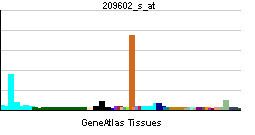Species Human Entrez 2625 | Human Mouse Ensembl ENSG00000107485 | |
 | ||
Aliases GATA3, HDR, HDRS, GATA binding protein 3 External IDs MGI: 95663 HomoloGene: 1550 GeneCards: GATA3 | ||
Transcription factor GATA-3 is a protein that in humans is encoded by the GATA3 gene.
Contents
Function
GATA-3 belongs to the GATA family of transcription factors. It regulates luminal epithelial cell differentiation in the mammary gland. The protein contains two GATA-type zinc fingers and is an important regulator of T cell development and plays an important role in endothelial cell biology. GATA-3 has been shown to promote the secretion of IL-4, IL-5, and IL-13 from Th2 cells, and induces the differentiation of Th0 cells towards this Th2 cell subtype while suppressing their differentiation towards Th1 cells. It is hypothesised that GATA-3 may play tissue-specific roles. It has been suggested that GATA-3 is regulated in CD4+ T cells at a transcriptional level through the IL-4 receptor, as well as translationally through T cell receptor signaling.
Clinical significance
Defects in this gene are the cause of hypoparathyroidism with sensorineural deafness and renal dysplasia.
Breast cancer
GATA-3 is one of the three genes mutated in >10% of breast cancers (Cancer Genome Atlas).
GATA-3 was shown to be required for the luminal A type of breast cancer, intertwined in pathways with ERα but also androgen receptor signaling in ER-/AR+ tumors.
Nuclear expression of GATA-3 in breast cancer is considered a marker of luminal cancer in ER+ cancer and luminal androgen responsive cancer in ER-/AR+ tumors. It is highly coexpressed with FOXA1 and serves as negative predictor of basal subtype and ERBB2 subtype. GATA-3 was shown to directly regulate luminal cell differentiation in mouse models of breast cancer. It is also considered a strong predictor of taxane and platin salts insensitivity.
Insulin has been shown in experimental models to downregulate expression of GATA3 by causing overexpression of T-bet, resulting in resistance to endocrine therapy.
Interactions
GATA3 has been shown to interact with LMO1, ER and FOXA1.
